As the site is updated, each listing includes the shipping cost. Some listings which I have not updated still give you calculated shipping costs based on weight and size of package. (In the sections I have updated) If you select several different listings, we will consolidate your order and charge you the actual cost of the entire package. The shipping over charge will be refunded to you, when your order is shipped.
COWRY SHELLS
Cowrie or cowry (pl cowries) is the common name for a group of small to large sea snails, marine gastropod mollusks in the family Cypraeidae, the cowries.
Cowries are generally seen on rocky areas of the sea bed.
The cowrie was the shell most widely used worldwide as shell money. It is most abundant in the Indian Ocean, and was collected in the Maldive Islands, in Sri Lanka, along the Indian Malabar coast, in Borneo and on other East Indian islands, in Maluku in the Pacific, and in various parts of the African coast from Ras Hafun to Mozambique. Cowrie shell money was important in the trade networks of Africa, South Asia, and East Asia.
In the United States and Mexico, cowrie species inhabit the waters off Central California to Baja California (the chestnut cowrie is the only cowrie species native to the eastern Pacific Ocean off the coast of the United States; further south, off the coast of Mexico, Central America and Peru, Little Deer Cowrie habitat can be found; and further into the Pacific from Central America, the Pacific habitat range of Money Cowrie can be reached as well as the waters south of the Southeastern United States.
(Cowrie". Infoplease.com.)
Cowry shells are usually smooth, shiny and more or less egg-shaped. The round side of the shell is called the Dorsal Face. The flat under side is called the Ventral Face, which shows a long, narrow, slit-like opening (aperture), which is often toothed at the edges. The narrower end of the egg-shaped cowrie shell is the anterior end. The broader end of the shell is called the posterior. The spire of the shell is not visible in the adult shell of most species, but is visible in juveniles, which have a different shape from the adults.
Cowries generally have a porcelain-like shine, with some exceptions such as Hawaii's granulated cowrie, Nucleolaria granulata. Many have colorful patterns. Cowries can grow from 1/5 inch and for some species up to 7 1/2 inches for the Atlantic deer cowrie, Macrocypraea cervus.
Scientific classification
Domain: Eukaryota
Kingdom: Animalia
Phylum: Mollusca
Class: Gastropoda
Subclass: Caenogastropoda
Order: Littorinimorpha
Super family: Cypraeoidea
Family: Cypraeidae
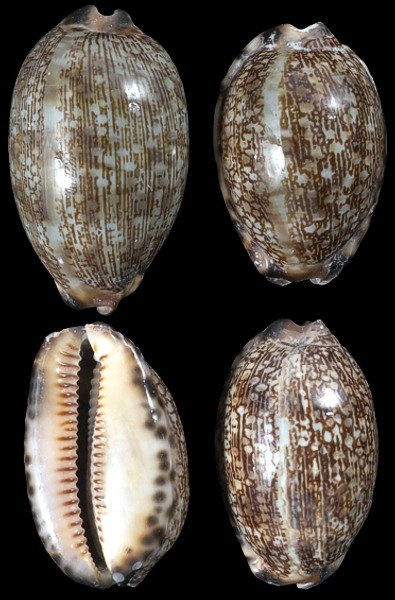
Mauritia arabica common name Arabian cowry
This species grows on average to about 3 inches. The Arabic cowry has been known to grow to near 4 inches (REF: Poutiers, J. M. (1998). Gastropods The living marine resources of the Western Central Pacific Volume 1).
The shell outline is oblong or nearly elliptical. The spire is barely distinguishable dorsally. Common with other Cypraeidae, the aperture of the shell is very narrow, and relatively long. Both the inner and outer lips are ornamented with arrays of small teeth. The dorsal side of the shell is convex or bent, and never depressed. The dorsal mantle groove (the line or area where the two mantle flaps meet when they are fully extended) is dissimilar to the shells general color pattern, and thus easily perceivable. The lateral margins are calloused, mainly towards both the posterior and anterior ends. The ventral side of the shell is typically flattened, and sometimes slightly concave (REF: Poutiers, J. M. (1998). Gastropods The living marine resources of the Western Central Pacific Volume 1).
The Arabic shell surface is notably effulgent (shiny), as if it had been deliberately polished. The color is generally cream to light fawn dorsally, with shades of brown. The ventral side of the shell is colored cream to grey. The labral teeth are reddish brown and white towards the columella. The common name Arabian cowry is based on a dense and irregular pattern of thin longitudinal brown lines which are sometimes interrupted by empty spaces, giving an appearance that is considered to be similar to that of Arabic script (REF: Poutiers, J. M. (1998). Gastropods The living marine resources of the Western Central Pacific Volume 1).
Mauritia arabica and its close relative Mauritia eglantina have very similar shells which can be easily confused. M. eglantina has a dark blotch or spot near the spire (M. arabica lacks this blotch) and generally has a narrower outline and more elongate-cylindrical shell form. (REF: Mauritia eglantina". Kwajalein Underwater)
Mauritia arabica are found in the Indo-West Pacific, from East and South Africa (including Madagascar, but not the Red Sea nor the Persian Gulf), to the eastern Polynesia. It spreads north to Japan and south to New South Wales, Australia (REF: Poutiers, J. M. (1998). Gastropods The living marine resources of the Western Central Pacific Volume 1).
This sea snail dwells under boulder and stones, and also shelters in caverns of the outskirts of coral reefs. It lives in low intertidal zones to shallow sublittoral depths. Mauritia arabica are mainly nocturnal.
Mauritia arabica is collected for food by locals in many areas (REF: Poutiers, J. M. (1998). Gastropods The living marine resources of the Western Central Pacific Volume 1).
Scientific classification
Domain: Eukaryota
Kingdom: Animalia
Phylum: Mollusca
Class: Gastropoda
Subclass: Caenogastropoda
Order: Littorinimorpha
Family: Cypraeidae
Genus: Mauritia
Species: M. arabica
Binomial name: Mauritia arabica
(Linnaeus, 1758)
F1-7
Six Arabic Cowrie shells, measuring 1.25 to 2.25 inches ..... $5.37
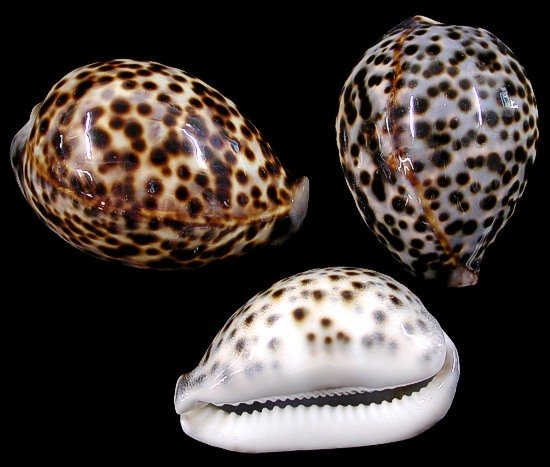
Cypraea Tigris, common name Tiger Cowrie
These Cowries are egg-shaped and dextral, the glossy shell is large and heavy for a cowry. Tiger Cowries have been found to grow up to 6 inches, and the upper or dorsal side is white, pale bluish-white, or buff. They are densely covered with dark brown or blackish barely circular spots. The shells surface are notably effulgent, as if it were deliberately polished. There is sometimes a blurred red line along the length of the shell at the midline on the dorsal surface. The lower margins are rounded, there is no sharp margin between the upper and lower surfaces of the shell as is found in some other cowries. The ventral side is white or whitish, and the shell opening is lined with tooth-like serrations.(REF: Poutiers, J. M. (1998). "Gastropods". In Carpenter, K. E (ed) )
Tiger Cowries have two lateral extensions of the mantle are able to extend them to cover the shell completely, meeting at the midline of the dorsal surface. The mantle can also withdraw into the shell opening when threatened. The exterior surface of the mantle has numerous pin-like projections that are white-tipped.
The tiger cowrie is found on the ocean floor in the Indo-Pacific region, from the eastern coast of Africa to the waters of Micronesia and Polynesia, the Coral Sea and around the Philippines. Along the Australian Coast it is found from northern New South Wales to northern Western Australia, as well as Lord Howe Island, and along the east coast of Africa including Madagascar. This species are found between depths of 35 to 130 feet. They are often associated with live coral colonies, such as the table-forming Acropora, either found on the reefs themselves or the sandy sea bottom nearby. The Tiger Cowry were once common, but now much less abundant due to shell collecting and the destruction of its habitat by such processes as dynamite fishing, especially in shallower areas. The adults are carnivorous, feeding on coral and various invertebrates, while juveniles eat algae.(REF: Poutiers, J. M. (1998). "Gastropods". In Carpenter, K. E (ed.))
Some Japanese women believe holding the Cypraea tigris helps facilitate the childbirth process.
Scientific classification
Kingdom: Animalia
Phylum: Mollusca
Class: Gastropoda
(unranked): clade Caenogastropoda
clade Hypsogastropoda
clade Littorinimorpha
Super family: Cypraeoidea
Family: Cypraeidae
Subfamily: Cypraeinae
Genus: Cypraea
Species: C. tigris
Binomial name: Cypraea tigris
Linnaeus, 1758
EE1-2-6
Two Tiger Cowrie shell, measuring between 2 to 3 inches...... $5.95
1EE1-2-6
Ten Tiger Cowrie shell, measuring between 2 to 3 inches...... $16.59
EE3-6
A Tiger Cowrie shell ranging in size from 3 to 3.5 inches........ OUT OF STOCK
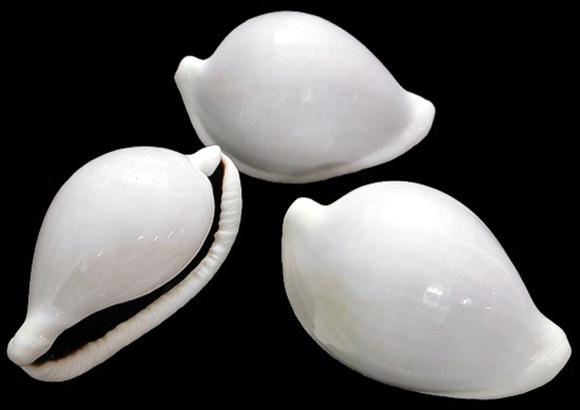
OVULA OVUM, common name egg cowrie(Ovula ovum (Linnaeus, 1758)
The Egg Cowry are common species that grow to an average of 2 to 3 inches. The minimum size of 2.0 inches, reaching a maximum length of about 4 1/2 inches. These species are egg-shaped which gives the common name ovum in Latin, meaning egg. The surface of the shell is smooth. They are shiny and completely snow white, with a dark reddish-purple interior that is visible through the wide and long aperture, which bears teeth on one side only. The living cowries have a black mantle with a pattern of small white spots in adults. The juveniles resemble some toxic nudibranchs of the genus Phyllidia owing to their orange yellow sensorial papillae. The lateral flaps of the mantle usually hide completely the white surface, but the mantle is quickly retracted into the shell opening when the cowry is disturbed.(REF: Ovula ovum (Linnaeus, 1758)
The Egg Cowry species are found in the Red Sea, in the Indian Ocean along East Africa (Aldabra, Madagascar, Mozambique, Mauritius, Tanzania, Kenya, Chagos) and in Western and Central Pacific Ocean (New Zealand, Australia, North Sulawesi, Malaysia, Borneo, New Caledonia, Philippines, French Polynesia and southern Japan).
Ovula ovum dwell in tropical reefs, shallow waters to depths of 7 to 66 feet, usually feeding on algae or soft corals, Alcyonarian colonies (REF: Leather Coral, genus Sarcophyton and Sinularia sp., Alcyoniidae).
(REF: Jean-François Hamel & Annie Mercier - Observations on the biology of the common egg shell Ovula ovum)
Scientific classification
Kingdom: Animalia
Phylum: Mollusca
Class: Gastropoda
(unranked): clade Caenogastropoda
clade Hypsogastropoda
clade Littorinimorpha
Super family: Cypraeoidea
Family: Ovulidae
Subfamily: Ovulinae
Genus: Ovula
Species: O. ovum
Binomial name: Ovula ovum
(Linnaeus, 1758)
C1-6
One Egg Cowry Shell measuring 2 to 3 inches. ...... OUT OF STOCK
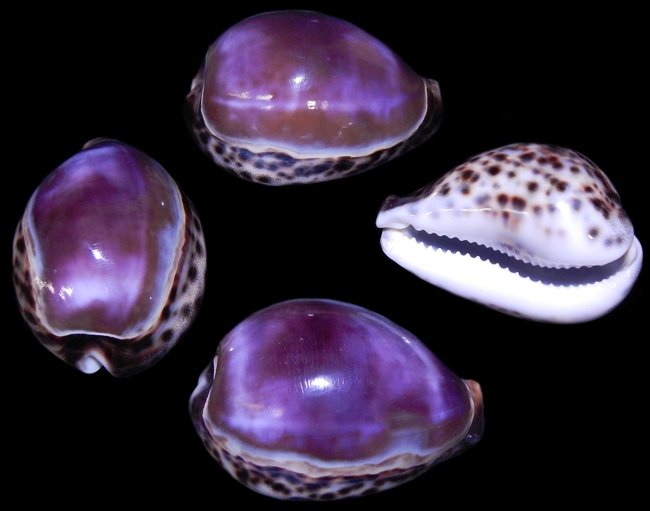
TIGER COWRY PURPLE TOP
Some cultures see cowry shells as a symbol of fertility and are often offered to a bride as a gift to ensure fertility. The outer shell is brown and black spotted, similar to a tiger, but the purple resides in a lower layer. To reach the purple of the shell, they are dipped into an acidic formula. Tiger cowries are also used in carvings like cameos due to this uniform color under the patterned shell.
(REF: "Cypraea tigris". Gastropods.com.)
JJ0-7
Two Purple Top Cowry shells, approximately 3 inches in size....... $5.99
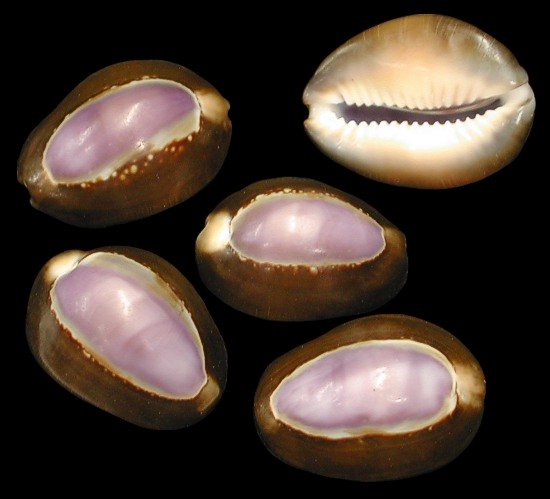
Cypraea Tigris Purple Top commonly called the Tiger Cowrie.
M1-7
Six Purple Top Tiger Cowrie shells, size ranging from 3/4 to 1 1/4 inches. ...... $5.75
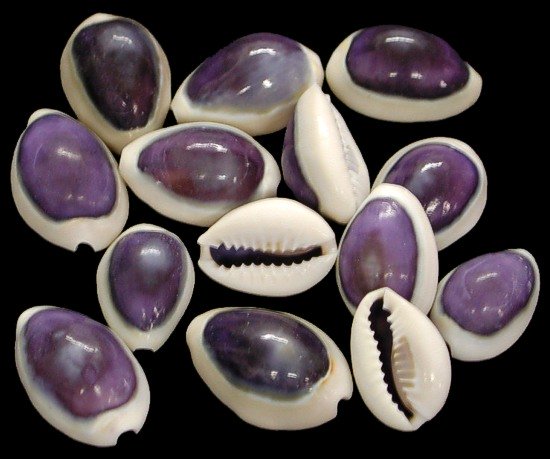
Cypraea Tigris Purple Top commonly called the Tiger Cowrie.
M2-7
Six Purple Top Cowrie shell measuring approximately half an inch. ...... $4.75
M22-7
Twenty Five Purple Top Cowrie shells measuring approximately half an inch. ...... $8
M222-7
Fifty Purple Top Cowrie shells measuring approximately half an inch. ...... $11.55
M2222-7
One hundred Purple Top Cowrie shells measuring approximately half an inch. ...... $19
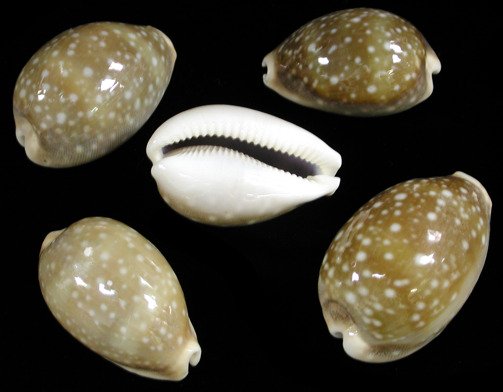
Lyncina Vitellus common name Pacific Deer Cowry
Deer Cowries grow to an average of 1 1/2 to 2 inches. The smallest length is 3/4 inches to a maximum of 4 inches.
The shape is usually pear-shaped, the dorsum surface is smooth and shiny and may be pale or dark brown, with several small white spots. The margins and the extremities are clearer, while the base is generally white, with a wide sinuous aperture and long labial teeth. The margins show numerous thin vertical whitish lines. The juvenile forms have two to three clearer transversal bands on the shell dorsum. The living cowries mantle is grey-brown, almost transparent, with long whitish tree-shaped papillae. The mantle and foot are well developed, with external antennae.
Deer Cowries dwell in the Red Sea and in the Indian Ocean along Aldabra, Chagos, the Comores, Kenya, Madagascar, the Mascarene Basin, Mauritius, Mozambique, Réunion, the Seychelles, Somalia and Tanzania and also along Jeju island, Philippines, Palau Islands, Samoa Islands, Polynesia, Hawaii and Vietnam.
These cowries live in tropical intertidal and subtidal water at depths to 82 feet. They prefer coral reefs, usually under coral slabs and stones.
References:
Lyncina vitellus (Linnaeus, 1758). WoRMS (2009). Lyncina vitellus (Linnaeus, 1758). Accessed through the World Register of Marine Species
Scientific classification
Kingdom: Animalia
Phylum: Mollusca
Class: Gastropoda
(unranked): clade Caenogastropoda
clade Hypsogastropoda
clade Littorinimorpha
Super family: Cypraeoidea
Family: Cypraeidae
Genus: Lyncina
Species: L. vitellus
Binomial name: Lyncina vitellus
(Linnaeus, 1758)
K1-7
Two Deer Cowrie Shells, ranging in size from 1 to 2 inches....... $4.95
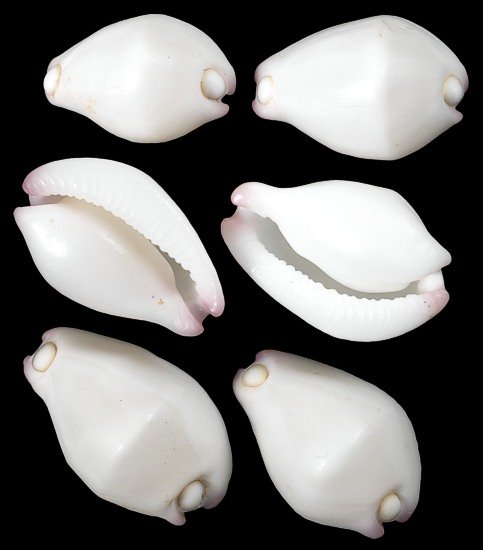
Calpurnus Verrucosuscommon name Wart Cowry
Wart Cowries species dwell in the tropical seas of South East Africa, in the Western Pacific Ocean, in the waters along Madagascar, Mascarene Islands, Red Sea, Indonesia, Thailand and the Philippines.
REF: Lorenz F. & Fehse D. (2009). The Living Ovulidae - A manual of the families of Allied Cowries
Wart Cowries grow on average from 1/3 to 1 1/2 inches. These cowries are pure white, smooth and ovate, the base is flat and wide. The anterior and posterior extremities have a slight purple coloration, with a yellow circle at the edge of a depressed pustule (hence the Latin name of this species, verrucosus ). The mantle of the living cowries is white and completely covered by small brown spots. The foot is white with dark dots and can be extended widely around the base of the shell.
REF: Lorenz F. & Fehse D. (2009). The Living Ovulidae - A manual of the families of Allied Cowries
Living cowries are active during daylight under soft corals, sponges and rocks in shallow to deep waters at a depth of 66 to depths of 165 feet. They feed on the polyps of Leather Corals (Sacrophyton and Lobophytum species, Alcyoniidae). This species is also active at night, when they spread their mantles on the top of the soft coral and start grazing on the polyps.
REF: Cate, C. N. 1973 - A systematic revision of the recent Cypraeid family Ovulidae
Scientific classification
Kingdom: Animalia
Phylum: Mollusca
Class: Gastropoda
(unranked): clade Caenogastropoda
clade Hypsogastropoda
clade Littorinimorpha
Super family: Cypraeoidea
Family: Ovulidae
Genus: Calpurnus
Species: C. verrucosus
Binomial name: Calpurnus verrucosus
(Linnaeus, 1758)
Q1-7
3 Wart Cowries Shell, size ranging from 3/4 to 1 1/4 inches....... $5.65
1Q1-7
Twenty five Wart Cowry Shells, size ranging from 3/4 to 1 1/4 inches....... $14.45
11Q1-7
Fifty Wart Cowry Shells, size ranging from 3/4 to 1 1/4 inches....... $23.25
111Q1-7
One hundred Wart Cowry Shells, size ranging from 3/4 to 1 1/4 inches....... $40.75
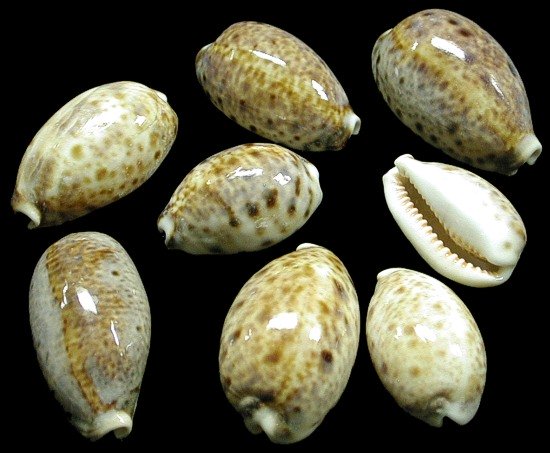
Lyncina Lynx, common name lynx cowry
Lynx cowry shells can very in pattern and size. They grow to an average length of 1 1/2 to 2 inches. Their minimum size is about 3/4 inch and a maximum size of 3 1/2 inches. The Lynx Cowry dorsum surface is smooth and shiny; color generally a pale brown, pale purple or grey, densely covered with small and large dark brown or purple dots. The large spots are extended to the edges. The base is white or pale brown. The aperture is long and narrow, with several white teeth and a bright reddish spacing. In the living cowries the mantle is transparent, with tree-shaped white sensorial papillae and may cover the entire shell.
REF: Lorenz F. & Hubert A. (2000) A guide to worldwide cowries. Edition 2
The Lynx Cowry dwells in the Red Sea, in the Indian Ocean along South-East Africa (Aldabra, Chagos, Kenya, Madagascar, the Mascarene Basin, Mauritius, Réunion, the Seychelles, Zanzibar and Tanzania) and in the western Pacific Ocean (Philippines, Japan, Taiwan, western and northern Australia, Polynesia and Hawaii).
REF: Lorenz F. & Hubert A. (2000) A guide to worldwide cowries. Edition 2
Lynx Cowries live in tropical shallow water, subtidal and intertidal, usually under rocks or corals up to about a depth of 33 feet. They are nocturnal, feeding at dusk, mainly on sponges.
Scientific classification
Kingdom: Animalia
Phylum: Mollusca
Class: Gastropoda
(unranked): clade Caenogastropoda
clade Hypsogastropoda
clade Littorinimorpha
Super family: Cypraeoidea
Family: Cypraeidae
Genus: Lyncina
Species: L. lynx
Binomial name: Lyncina lynx
(Linnaeus, 1758)
D2-7
One Lynx Cowry shell, ranging from 1/2 to 2 inches in size....... $2.25
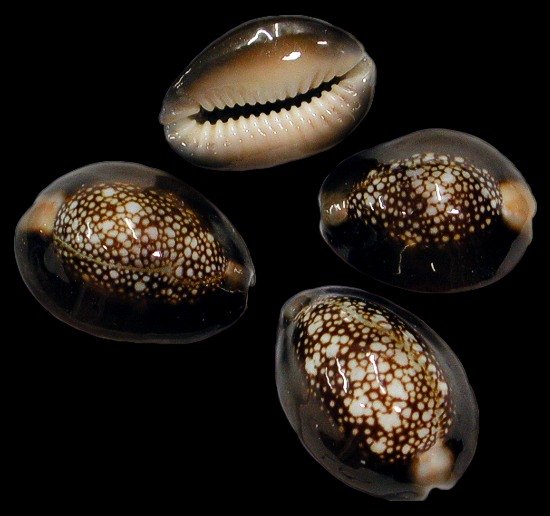
Monetaria caputserpentis, common name Snake head Cowry
Monetaria caputserpentis is a species of cowry, a sea snail, a marine gastropod mollusk in the family Cypraeidae, the cowries.
These cowries are found in the Red Sea, Indian Ocean, tropical Indo-West Pacific, Australia and the Philippines. These sea snails live on corals, rock reefs and rocky shores from the intertidal zone down to depths of 657 feet. Some have been found feeding on algae or seaweed using its file-like radula. The Snakehead is rarely found in water deeper than 10 feet
The basic color of the Snakehead Cowry is reddish-brown, with many whitish dots on the top of the dorsum, which sometimes shows a clear longitudinal line. The underside is light beige. Cowries, like most other snails, have: a well-developed head with eyes and tentacles and a mouth; a broad muscular foot for crawling; and a soft body mass (containing the internal organs) which is protected by their shell.
Snakehead Cowries are often sold with a purple top, which is achieved by dipping the dorsum in acid.
Scientific classification
Domain: Eukaryota
Kingdom: Animalia
Phylum: Mollusca
Class: Gastropoda
Subclass: Caenogastropoda
Order: Littorinimorpha
Family: Cypraeidae
Genus: Monetaria
Species: Monetaria caputserpentis
Binomial name: Monetaria caputserpentis
(Linnaeus, 1758)
(REF: WoRMS : Monetaria caputserpentis )(REF: Cantera J. R. (1991). "First record of the Indo-Pacific gastropod Cypraea caputserpentis (Linnaeus, 1758) at Isla Gorgona, Colombia")(REF:Meyer C. 2003. Molecular systematics of cowries (Gastropoda: Cypraeidae) and diversification patterns in the tropics. Biological Journal of the Linnean Society )
R1-10
Three Snake Head Cowrie shells, ranging in size from 3/4 to 1 1/4 inches....... $4.99
1R1-10
Twenty five Snake Head Cowrie shells, ranging in size from 3/4 to 1 1/4 inches....... $8.59
11R1-10
Fifty Snake Head Cowrie shells, ranging in size from 3/4 to 1 1/4 inches....... $12.25
111R1-10
One hundred Snake Head Cowrie shells, ranging in size from 3/4 to 1 1/4 inches....... $18.71
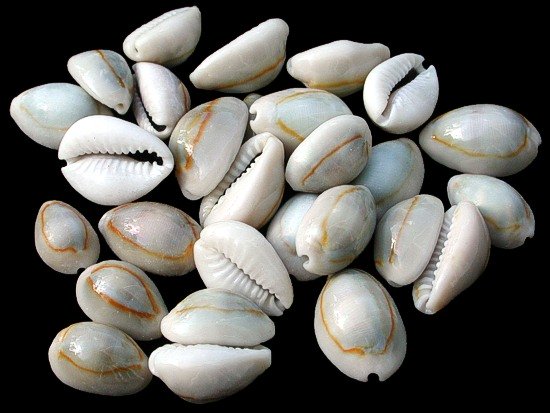
Ring Top Cowries are species of the sea snail, a cowry, a marine gastropod mollusk in the family Cypraeidae, the cowries.
Ring Top Cowries on average grow between 1/3 to 2 inches. The shell of this species is mostly off-white or pale yellowish in color, sometimes with a dark cast on the dorsum, and with two yellow or orange stripes along the upper sides. These stripes nearly touch at the ends, giving the impression of a ring.
Scientific classification
Domain: Eukaryota
Kingdom: Animalia
Phylum: Mollusca
Class: Gastropoda
Subclass: Caenogastropoda
Order: Littorinimorpha
Family: Cypraeidae
Genus: Monetaria
Species: Monetaria annulus
Binomial name: Monetaria annulus
(Linnaeus, 1758)
(REF:Monetaria annulus (Linnaeus). WoRMS (2009). Monetaria annulus (Linnaeus) (REF: "Monetaria annulus". Gastropods.com. ) (REF:Canku Ota - April 20, 2002 - Elk-teeth Dress is Epitome of Crow Status and Style" )
N1-11
Ten Ring Top Cowrie shells measuring up to 3/4 inch....... $4.99
1N1-11
Twenty five Ring Top Cowrie shells measuring up to 3/4 inch....... $7.85
11N1-11
Fifty Ring Top Cowrie shells measuring up to 3/4 inch....... $10.33
111N1-11
One hundred Ring Top Cowrie shells measuring up to 3/4 inch....... $15.75
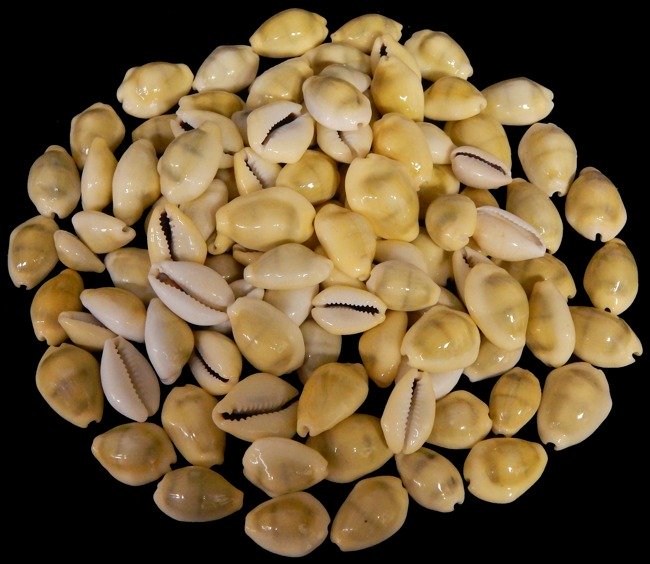
Monetaria moneta, common name the Money Cowrie
The Money Cowrie, is a species of the small sea snail, a marine gastropod mollusk in the family Cypraeidae, the cowries
This species is called "money cowrie" because the shells were historically widely used in many Pacific and Indian Ocean countries as shell money before coinage was in common usage.(REF: WoRMS : Monetaria moneta)
It is a quite small cowry, up to 3 cm (1.2 in), irregular and flattened, with very calloused edges and roughly subhexagonal. The color is pale (from white to dirty beige), but the dorsum seems transparent, often greenish grey with yellowish margins, with sometimes darker transverse stripes and a delicate yellow ring. The opening is wide and white, with pronounced denticules. The mantle of the live animal is mottled with black and off-white.
The Monetaria moneta shells varies widely in shape and color; resulting in the species having numerous taxonomic synonyms.
The Money Cowry is found across the Indo-Pacific tropical waters. They are present in numerous regions, including East and South Africa, Madagascar, the Red Sea and the Persian Gulf, Maldives, eastern Polynesia, Galapagos, Clipperton and Cocos islands off Central America, southern Japan, Midway and Hawaii, and northern New South Wales and Lord Howe Island (REF: Poutiers, J. M. (1998). Gastropods).
Money Cowries live in intertidal rocky areas and shallow tide pools among sea weed, coral remains, and empty bivalve shells. It can be found on and under rocks in shallow water and on exposed reefs at low tide. It feeds on algae and marine vegetation growing on loose rocks and pieces of dead coral (REF: Poutiers, J. M. (1998). Gastropods).
Money cowries were commonly used as a medium of exchange in many areas of Africa, Asia and the Pacific islands until the late 19th century (REF: Poutiers, J. M. (1998) Gastropods).
The Maldives provided the main source of cowrie shells, throughout Asia and parts of the East African coast. Huge amounts of Maldivian cowries were introduced into Africa by slave traders.
Money Cowries were also traded to Native Americans by European settlers (REF: Hogendorn, Jan and Johnson Marion: The Shell Money of the Slave Trade. African Studies Series 49, Cambridge University Press, Cambridge, 1986).
Scientific classification
Domain: Eukaryota
Kingdom: Animalia
Phylum: Mollusca
Class: Gastropoda
Subclass: Caenogastropoda
Order: Littorinimorpha
Family: Cypraeidae
Genus: Monetaria
Species: M. moneta
Binomial name: Monetaria Moneta
(Linnaeus, 1758)
G1-11
Ten Money Cowry Shells, measuring up to 1 inch....... $4.99
1G1-11
Twenty five Money Cowry Shells, measuring up to 1 inch....... $6.35
11G1-11
Fifty Money Cowry Shells, measuring up to 1 inch....... $8.85
111G1-11
One hundred Money Cowry Shells, measuring up to 1 inch....... $12.35